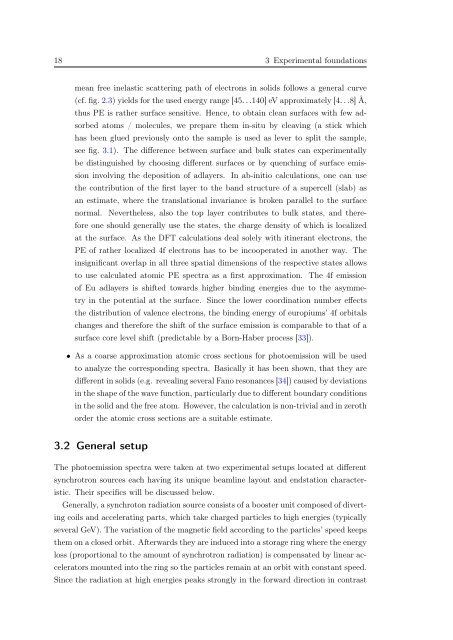Diploma - Max Planck Institute for Solid State Research
Diploma - Max Planck Institute for Solid State Research
Diploma - Max Planck Institute for Solid State Research
Create successful ePaper yourself
Turn your PDF publications into a flip-book with our unique Google optimized e-Paper software.
18 3 Experimental foundations<br />
mean free inelastic scattering path of electrons in solids follows a general curve<br />
(cf. fig. 2.3) yields <strong>for</strong> the used energy range [45. . .140] eV approximately [4. . .8] Å,<br />
thus PE is rather surface sensitive. Hence, to obtain clean surfaces with few adsorbed<br />
atoms / molecules, we prepare them in-situ by cleaving (a stick which<br />
has been glued previously onto the sample is used as lever to split the sample,<br />
see fig. 3.1). The difference between surface and bulk states can experimentally<br />
be distinguished by choosing different surfaces or by quenching of surface emission<br />
involving the deposition of adlayers. In ab-initio calculations, one can use<br />
the contribution of the first layer to the band structure of a supercell (slab) as<br />
an estimate, where the translational invariance is broken parallel to the surface<br />
normal. Nevertheless, also the top layer contributes to bulk states, and there<strong>for</strong>e<br />
one should generally use the states, the charge density of which is localized<br />
at the surface. As the DFT calculations deal solely with itinerant electrons, the<br />
PE of rather localized 4f electrons has to be incooperated in another way. The<br />
insignificant overlap in all three spatial dimensions of the respective states allows<br />
to use calculated atomic PE spectra as a first approximation. The 4f emission<br />
of Eu adlayers is shifted towards higher binding energies due to the asymmetry<br />
in the potential at the surface. Since the lower coordination number effects<br />
the distribution of valence electrons, the binding energy of europiums’ 4f orbitals<br />
changes and there<strong>for</strong>e the shift of the surface emission is comparable to that of a<br />
surface core level shift (predictable by a Born-Haber process [33]).<br />
• As a coarse approximation atomic cross sections <strong>for</strong> photoemission will be used<br />
to analyze the corresponding spectra. Basically it has been shown, that they are<br />
different in solids (e.g. revealing several Fano resonances [34]) caused by deviations<br />
in the shape of the wave function, particularly due to different boundary conditions<br />
in the solid and the free atom. However, the calculation is non-trivial and in zeroth<br />
order the atomic cross sections are a suitable estimate.<br />
3.2 General setup<br />
The photoemission spectra were taken at two experimental setups located at different<br />
synchrotron sources each having its unique beamline layout and endstation characteristic.<br />
Their specifics will be discussed below.<br />
Generally, a synchroton radiation source consists of a booster unit composed of diverting<br />
coils and accelerating parts, which take charged particles to high energies (typically<br />
several GeV). The variation of the magnetic field according to the particles’ speed keeps<br />
them on a closed orbit. Afterwards they are induced into a storage ring where the energy<br />
loss (proportional to the amount of synchrotron radiation) is compensated by linear accelerators<br />
mounted into the ring so the particles remain at an orbit with constant speed.<br />
Since the radiation at high energies peaks strongly in the <strong>for</strong>ward direction in contrast
















